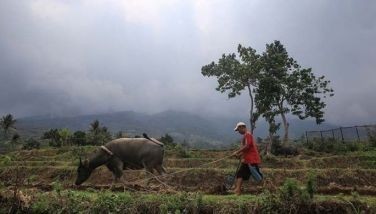Payatas tragedy: One year after
July 10, 2001 | 12:00am
 After a wall of garbage came tumbling down a year ago at the Payatas dumpsite in Quezon City, Jayson Banogon, who was nine at the time, suddenly found himself orphaned.
After a wall of garbage came tumbling down a year ago at the Payatas dumpsite in Quezon City, Jayson Banogon, who was nine at the time, suddenly found himself orphaned.
Banogon lost both his parents and four-month-old brother in the trashslide of July 10, 2000, buried alive along with hundreds of residents in the barangay ironically called Lupang Pangako.
He could have died, too, along with his family had his mother not sent him on an errand the night before. Since it would be late by the time he would be making his way home, his mother instructed him to spend the night in his grandmother’s house in the nearby barangay.
The home Jayson knew was no longer there when he returned the next morning. Instead there was the general commotion of search and rescue teams sifting through heaps of trash, trying to retrieve bodies from under garbage that caved in on about 300 shanties.
"Sabi po nung ibang kapitbahay nakita raw nila ang Papa at Mama kong tumatakbo palayo pero naabutan pa rin sila ng gumuguhong basura. Di ko na po sila nakita (Some of our neighbors said they saw my parents running away from the collapsing garbage but it still caught up with them)," Jayson told The STAR in an interview.
When the mountain trash caved in, it seemed that nothing, not even his dream of one day becoming an architect, was left for Jayson. It was his father who had convinced him to take up architecture in college.
Over the weekend, Jayson, 10, called on President Arroyo to help his grandmother ensure his education up to college so he could build houses far from any dumpsite.
Last Sunday, Jayson, along with Rica Donna Sayson, 13, Jomar Pabalan, 10, Erwin Dolera, nine, and other Payatas children made letters of demands which they transformed into paper boats and sent them off through the Pasig River to Malacañang.
The children hoped their letters reach the President before the one-year anniversary of the tragedy today.
In their letters, the children asked Mrs. Arroyo to help them get justice for the occupants of about 300 shanties, who were all sound asleep when the mountain of garbage eroded, burying their houses.
A total of 232 people were killed while 655 families were rendered homeless because of the incident.
Some of the affected families were relocated to Rodriguez (formerly Montalban), Rizal, while some opted to stay at the dumpsite.
The children, in their letters, also asked the government to permanently close the dumpsite to prevent any similar incident.
But Delia Badion, chairwoman of the July 10 Payatas Victims Organization, said the relocated families in Montalban now want to return to Payatas.
"Life in the relocation site is more miserable than it was in Payatas. For a year, the children were forced to stop their education because there is no school inside the relocation," Badion said.
At the height of search and rescue operations at the trashslide, then President Joseph Estrada ordered the immediate closure of the dumpsite in Barangay Lupang Pangako.
It was however reopened a few weeks later when then Mayor Ismael Mathay Jr. appealed that it be reopened to prevent an epidemic of illness due to uncollected garbage.
The new Mayor Feliciano Belmonte Jr. said the Payatas dumpsite has to be closed to prevent a similar tragedy from recurring. He said he would try to properly manage collection and disposal of garbage in the city.
The mayor has met with members of the Quezon City Disaster Coordinating Council (QCDCC) and Quezon City Solid Waste Management (QCSWM) to discuss the plight of the victims of the dumpsite and work out ways of proper garbage management.
"What we want to do here in Quezon City is to remove the dumpsite by establishing a composting center where we can treat our garbage," Belmonte said. "We hope to make these alternative ideas work out."
BrandSpace Articles
<
>
- Latest
- Trending
Trending
Latest
Trending
Latest
Recommended
January 10, 2025 - 12:00am






























